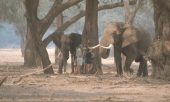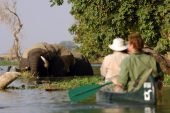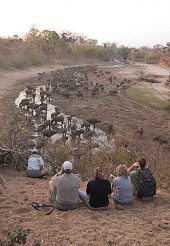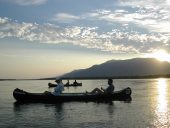Canoeing and walking through Mana Pools National Park in Zimbabwe
It would be hard to find a better place to drift down a wild river dodging pods of hippo and skirting submerged elephants crossing channels. Or walking freely through the bush stumbling across a pride of lion, and a leopard in the fork of a tangled wild fig tree. Mana Pools is unique and offers a rare privilege to get closer to wild Africa and sleep under the stars. Below appears a story of a previous visit and some facts on the park…James Varden runs some outstanding trips along the river.
After leaving Vic Falls we took the road east to transit through Zambia and back into Zimbabwe at Chirundu. According to local advice the state of the alternative dirt road through Zimbabwe was nearly as bad as Mugabe’s economic policies and was to be avoided at all cost. In addition there was no fuel in sight at fuel stations, the line for a loaf of bread was stretching 300 metres from the bakery and milk has all but dried up in the markets, and Vic Falls has it good in comparison with some parts of the country.
We restocked in Livingstone in amongst the putrid armpits of the seething mass of flesh that was on the streets. We were hassled by some thugs, trying to extort money for looking after the car, and made east as soon as we could. The drive was easy but not scenic until we rolled south on the last stretch to Chirundu on the border through some picturesque hills. We passed through customs and arrived back on the banks of the Zambezi at sunset and prepared for the next safari.
I was a little apprehensive returning for the third time to canoe the lengths of the Lower Zambezi. Concerned that it may not live up to the previous two experiences, considering the state of the country and the impact of poaching in Mana Pools. Bridget, our contact in Harare painted a picture that assured us that Mana Pools had been left as it always had been – pristine and untouched.
The road in was certainly as I remembered it, rutted with corrugations and the bush was tinder dry around us. We reached the floodplain and the effect of the drought had meant the animals had cleared the ground of all edible material to the hard-packed earth, the trees had been hammered to neat levels as far as the browsers could reach and the view was unimpeded under the tree canopies. It made for excellent spotting. The floodplain only stretched a couple of kilometres inland and most of the game was crammed into this thin parcel of ground.
We had opted for a five night mobile safari combining bush walks, game drives and canoeing, with Natureways, giving us the best possible bush experience with a high level of comfort. A bit different to our do-it-yourself safaris we have experienced over the last few months. Added to this we had a guide whose eyes were used to the bush and whose knowledge of the animals and the area were to provide insights that we could not have achieved on our own.
Mana Pools is unique as a park as they allow you to walk freely wherever you want to go, during the daylight hours, and is one of the only parks that allows canoe safaris in Africa. This combination makes for interesting encounters with the big game that you cannot experience in a vehicle. Nigel, who studied for four years to qualify as a guide (arguably the most thorough training for professional guides anywhere) knew some of the beasts we came upon and we were able to walk up within metres of bull elephants.
Adrenalin grass is the name given to a tall, fibrous grass that grows in large patches, and it is the last fodder the animals eat, when there is nothing left. Already these sporadic patches were being consumed, as the drought is taking its toll and the rains are not expected until October. The name is apt as it often is the refuge of predators during the daylight hours as it gives cover for hunting and shade from the sun. When you are on foot, as we were, we gave the grass a wide berth.
On our first walk nearing dusk we were walking back from the river to the vehicle and Helen wondered if we were ever destined to spot leopard on our travels.
Our first sign was Nigel stopping and a raised hand, motioning us forward slowly. There was a particularly thick patch of adrenalin grass one hundred metres ahead of us. And there it was, a flickering black-tipped tail. As we looked closer we made out 6 adult lions lying on the edges of the grass watching us. It felt strangely normal to be standing so close to beasts that would normally sends volumes of terror through your bones, but it was the calmness and confidence of our guide that made it feel so relaxed. We edged closer and then they disappeared into the grass. As we watched, Nigel exclaimed to his astonishment as he picked out the shape of a leopard only 50 metres further on relaxing under the shade of a tree surveying the plain below, seemingly unaware of its mortal enemies lying in the grass. It was very unusual to see them in such close proximity, unaware of each other’s presence. We watched and circled around back to the vehicle and drove closer to watch our first sighting of leopard.
One of the most overwhelming experiences was looking up at the stars through the see-through roof of our tent and listening to the sounds of the African night. The haunting sound of the ground hornbill before dawn; the startling trumpet of elephants; the odd whooping call of the hyena; the nightbirds; the insects; the warning snort of the impala, and the tremendous sound of lion. Lion instills the greatest fear of them all and they arrived at 4.45 am in camp.
At first it was in the far distance a number of lions calling to each other and then it arrived suddenly, the wall of deep sound that grips your body so tightly you dare not breathe. We were all in our tents, including the camp staff, as the pride ripped through the campsite, either side of the tents, roaring intermittently as they moved. As the sound moved away we relaxed and waited for dawn to break. At first light we all crawled out of our tents and inspected the pug marks that ran metres from our tents and came across some fresh pieces of bloodied bone that were the leftovers of a small kill the lions had made when they came through. We tracked the lions before breakfast and found two males ambling into the adrenalin grass 250 metres from camp.
On foot again we came across elephants and came within feet of the giant pachyderms. In one of the pools, immersed in thick water hyacinth, was a great bull that we approached on foot. This one we captured on film as Nigel strode up to the edge of the pool. Once he was aware of our presence he came effortlessly out of the lilies and mock charged Nigel, who was on his haunches. It was a fantastic sight as the ears were fanned out and it climbed the low bank towering metres above Nigel and blasting his trumpet. It was a bull that Nigel knew and after his initial annoyance of being disturbed during his meal, moved into the scrub.
We canoed the last three days and had many more encounters at close range. The hippos were a constant presence in the channels of the Zambezi as were the large crocodiles on the banks. Waterbuck, sable antelope, lechwe and buffalo were along the banks and on the islands. The birds were all around us and provided the music mixed with the dipping of paddles in the river. The game and the scenery, the knowledge and the encounters were rounded off with gin and tonics, great bush cooking, fantastic hosts and fine discussions around the dinner table at night.
INTRODUCTION TO MANA POOLS by Natureways
Mana Pools National Park is situated along 80 kilometres of the Zambezi River, making for the best game viewing on the lower Zambezi. Here one can participate in canoeing, walking and /or game drives – or simply relax and take in the breathtaking beauty. Mana Pools is consistently rated in the top ten of Africa’s National Parks.
Mana Pools is the only game park in Zimbabwe to be granted World Heritage Status and encompasses some of Africa’s largest areas of Acacia and Mahogany woodland, combined with spectacular, full-canopy Mopane forest. Mana Pools is part of a 300 million year old rift valley supporting a large variety of mammals and over 400 bird species. Covering over 200 square kilometres this national park has been set aside to be kept as wild as possible with only non-invasive, zero-impact tourism allowed. There are no safari lodges, generators, electric fences or other structures often associated with safari camps as these are banned by law. All our camps must be taken down the day after our clients depart to ensure minimal damage to the ecosystem.
Wildlife is abundant in the valley especially during from June through to late October. The River runs through the Urungwe Safari Area, Mana Pools National Park, Sapi Safari, Chewore Safari and Dande Safari areas respectively. Wildlife will be seen on every trip, most commonly impala, waterbuck, hippo, crocodiles, elephant and buffalo. Animals such as lion, leopard, etc, are more difficult to see but are certainly present. Wildlife is much more abundant in Mana Pools, especially during the height of the dry season (July to October) when the game viewing can be fantastic.
Games drives are in open-top 4WD Toyota Land Cruisers. These drives may take you away from the river, to investigate the different inland habitats and the diverse occupants that make up the ecology of the area. Walking to explore and learn about the area, with your Professional Guide is the best way to experience the incredible diversity of animals, insects and flora at Mana Pools. Your guide carries a weapon at all times. Mana Pools can provide some amazing experiences, if you are looking for close encounters with game. Mana is famous for its bull elephants, and if we are lucky enough to encounter one of these gentle giants on foot, it is an experience never to forget!
Canoeing is a wonderful way to take in the tranquility of the bush, gliding past herds of animals often unaware or uncaring of our presence. Canoeing is done in 18ft Canadian style canoes, fitted with comfortable seats and cushions.
We are only too happy to cater for guests with any particular special interests, such as birding, photography, botany etc. Please advise us of any special interests prior to arrival. Ideally each guest should have his or her own set of binoculars to maximize the safari experience.
Fishing is also a popular activity from Camp Zambezi particularly towards the end of the dry season – Sept/Oct when the tiger fish are biting.





1 Comment
Join the discussion and tell us your opinion.
Don’t forget to carry a camera to capture the panoramic view of
the Game Park and activities of its wilderness. People all over the world have the same number of melanin producing cells.
This spectacular setting is the home of some of Africa’s largest populations
of remaining wildlife.